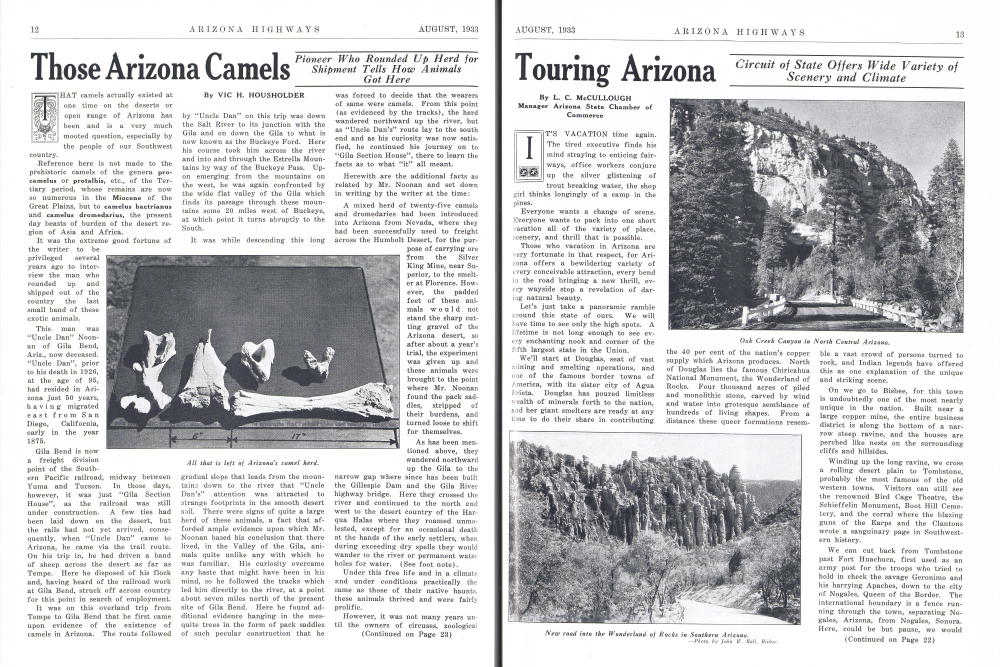Those Arizona Camels

Those Arizona Camels Pioneer Who Rounded Up Herd for Shipment Tells How Animals Got Here
THAT camels actually existed at one time on the deserts or open range of Arizona has been and is a very much mooted question, especially by the people of our Southwest country.
Reference here is not made to the prehistoric camels of the genera procamelus or protalbis, etc., of the Tertiary period, whose remains are now so numerous in the Miocene of the Great Plains, but to camelus bactrianus and camelus dromedarius, the present day beasts of burden of the desert region of Asia and Africa.
It was the extreme good fortune of the writer to be privileged several years ago to interview the man who rounded up and shipped out of the country the last small band of these exotic animals.
This man was "Uncle Dan" Noonan of Gila Bend, Ariz., now deceased. "Uncle Dan", prior to his death in 1926, at the age of 95, had resided in Arizona just 50 years, having migrated east from San Diego, California, early in the year 1875.
Gila Bend is now a freight division point of the Southern Pacific railroad, midway between Yuma and Tucson. In those days, however, it was just "Gila Section House", as the railroad was still under construction. A few ties had been laid down on the desert, but the rails had not yet arrived, consequently, when "Uncle Dan" came to Arizona, he came via the trail route. On his trip in, he had driven a band of sheep across the desert as far as Tempe. Here he disposed of his flock and, having heard of the railroad work at Gila Bend, struck off across country for this point in search of employment.
It was on this overland trip from Tempe to Gila Bend that he first came upon evidence of the existence of camels in Arizona. The route followed
By VIC H. HOUSHOLDER
by "Uncle Dan" on this trip was down the Salt River to its junction with the Gila and on down the Gila to what is now known as the Buckeye Ford. Here his course took him across the river and into and through the Estrella Mountains by way of the Buckeye Pass. Upon emerging from the mountains on the west, he was again confronted by the wide flat valley of the Gila which finds its passage through these mountains some 20 miles west of Buckeye, at which point it turns abruptly to the South.
It was while descending this long gradual slope that leads from the mountains down to the river that "Uncle Dan's" attention was attracted to strange footprints in the smooth desert soil. There were signs of quite a large herd of these animals, a fact that afforded ample evidence upon which Mr. Noonan based his conclusion that there lived, in the Valley of the Gila, animals quite unlike any with which he was familiar. His curiosity overcame any haste that might have been in his mind, so he followed the tracks which led him directly to the river, at a point about seven miles north of the present site of Gila Bend. Here he found additional evidence hanging in the mesquite trees in the form of pack saddles of such pecular construction that he Was forced to decide that the wearers of same were camels. From this point (as evidenced by the tracks), the herd wandered northward up the river, but as "Uncle Dan's" route lay to the south end and as his curiosity was now satisfied, he continued his journey on to "Gila Section House", there to learn the facts as to what "it" all meant.
Herewith are the additional facts as related by Mr. Noonan and set down in writing by the writer at the time: A mixed herd of twenty-five camels and dromedaries had been introduced into Arizona from Nevada, where they had been successfully used to freight across the Humbolt Desert, for the purpose of carrying ore from the Silver King Mine, near Superior, to the smelter at Florence. However, the padded feet of these animals would not stand the sharp cutting gravel of the Arizona desert, so after about a year's trial, the experiment was given up and these animals were brought to the point where Mr. Noonan found the pack saddles, stripped of their burdens, and turned loose to shift for themselves.
As has been mentioned above, they wandered northward up the Gila to the narrow gap where since has been built the Gillespie Dam and the Gila River highway bridge. Here they crossed the river and continued to the north and west to the desert country of the Har-qua Halas where they roamed unmolested, except for an occasional death at the hands of the early settlers, when during exceeding dry spells they would wander to the river or permanent water holes for water. (See foot note).
Under this free life and in a climate and under conditions practically the same as those of their native haunts, these animals thrived and were fairly prolific.
However, it was not many years until the owners of circuses, zoological (Continued on Page 23)
Already a member? Login ».